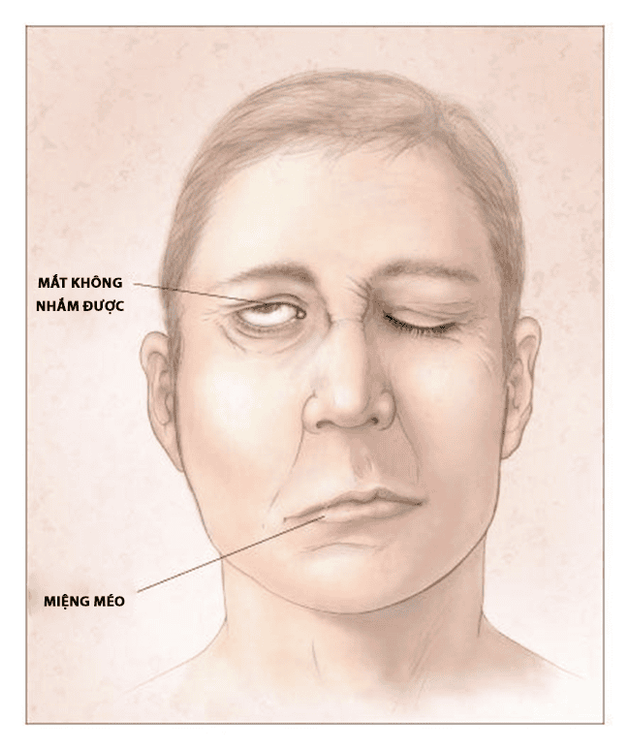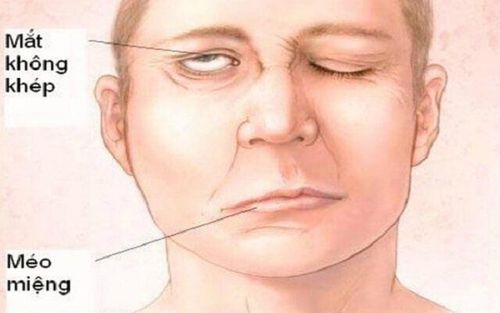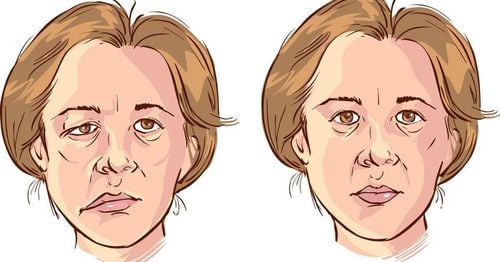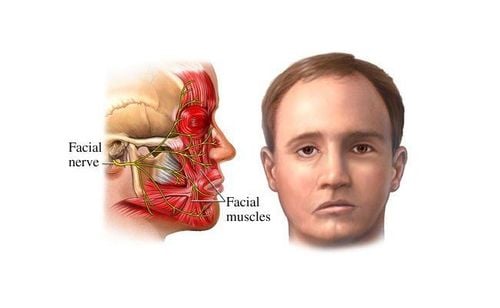This is an automatically translated article.
Patients with damage to the facial nerve (7th cranial nerve) - including central or peripheral facial palsy - result in weakness of the facial expressive muscles. 7th nerve graft surgery is one of the most popular solutions today to treat this condition.1. What is the main function of the 7th nerve?
The 7th cranial nerve, also known as the facial nerve, has the main function of movement (but there are also a number of sensory fibers that go from the external ear canal, some of which are responsible for controlling water secretion). foam and taste fibers coming from the anterior part of the tongue - will quickly belong to the tympanic cord).In addition, the facial nerve also branches to the stapes muscle (so damage to the entire 7th nerve changes the subtlety and sensitivity of hearing on the affected side).
2. Causes of 7th nerve paralysis
Injury to the 7th nerve can cause hemiplegia, stemming from many different causes, such as trauma to the base of the skull, or broken bones that have broken or crushed, nerve compression, in addition. It can also be the result of middle ear surgery into the labyrinth, surgery to remove tumors in the 7th nerve.In addition, surgery on the temporomandibular joint, surgery to conduct drainage of pus. of the temporal and cheek areas also become causes of damage to the 7th nerve.
Some medical causes leading to 7th nerve paralysis are inflammation of the parotid and submandibular areas, ear infections. between , cerebrovascular accidents or brain tumors .

Tổn thương của dây thần kinh số 7 gây liệt nửa mặt
3. Common clinical symptoms
Tinnitus: this is one of the most common onset symptoms, patients have a feeling of tinnitus or hearing like a tick is ringing in their head. There is gradual hearing loss and can lead to complete loss of hearing leading to deafness, most of the cases are usually deaf in one ear. Vestibular-cerebellar syndrome is one of the typical symptoms of 7th cranial nerve palsy with manifestations of dizziness, unsteady steps, loss of balance,... Increased intracranial pressure syndrome. This symptom usually appears when the tumor is large and presses on the 4th ventricle, causing ventricular dilatation, with typical manifestations of headache, papilledema, and nausea. Some symptoms of nerve compression of the adjacent skull, for example: facial numbness due to compression of the 5th nerve, the patient has peripheral hemifacial paralysis due to the compression of the 7th nerve, the appearance of strabismus due to compression. pressure on the 6th cord, hard to talk, difficult because of nerve compression 9,... Patients with severe changes, tumor spread and compression can lead to bed paralysis, falling into a coma, even death.
Hội chứng tiền đình là triệu chứng điển hình của liệt dây thần kinh số 7
4. Surgery to transplant the 7th cranial nerve
In cases where the patient is injured (broken nerve, crushed part), the doctor may intervene in the damaged area. This can be either de-adhesion or compression, end-to-end reattachment of the nerve, or the use of a typical nerve segment as a graft to restore this continuum.In addition, we can also remotely connect the 7th nerve segment on the affected side to the central branches of other motor nerves. Here are some methods:
Grafting to nerve 11: by splitting nerve 11 in half and cutting out half of this nerve, then proceed to end-to-end or splicing with the peripheral head of the 7th nerve being paralyzed. Or can proceed to splicing nerve 9 with nerve 7 by doing the same. Connects the peripheral end of the 7th nerve to the central end of the 7th nerve on the healthy side. However, for these methods, after the patient recovers, the 7th nerve on the right side will direct the muscle movement of the contralateral side. In fact, the recovery rate of nerve conduction after successful surgery is not high, so it is rarely used today.
Instead, the leading medical centers often use the method of nerve transplantation by microsurgery to overcome the disadvantages of the old methods. This surgery will not only help to get the muscle to stretch on the paralyzed side, but it can also add plastic to the atrophied half of the face. In particular, surgery will be divided into 2 main parts as follows:
First part: connecting the nerve on the healthy side to the affected side with the aim of nerve conduction that will be able to control the muscle that has just been encountered. And this part, can be prepared in advance based on transfacial surgery or performed simultaneously with muscle grafting (if the muscle flap is accompanied by a potentially long enough nerve). The compound muscle that can be used is a tapered muscle, but it can also be a dental muscle or part of the large back muscle. These muscles are attached to the vascular peduncle, are placed under the foot, divide into different branches and replace the oblique muscles of the cheekbones. Anastomosis can be performed by microsurgery with a tip that will be attached to the muscle of the lip ring. In particular, the motor nerve graft will be connected to the transfacial nerve, so if using the dorsal granulomatous muscle, it is necessary to take the nerve segment up to 20-24cm, so there is no need to reserve the segment. nerve graft.
Currently, neuromuscular transplantation surgery to restore function for the 7th nerve is being evaluated as a highly effective method. This is a difficult surgery, requiring highly specialized knowledge from the surgeon, so you should visit and treat at reputable hospitals.
For safe and effective treatment of 7th nerve palsy, you can contact the neurology department of Vinmec International General Hospital to be assigned specific treatment for each case by doctors. fit.













